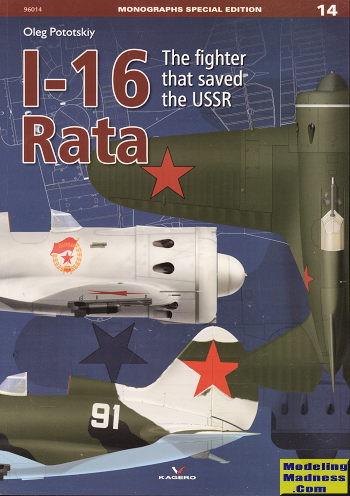Kagero's Polikarpov I-16 Rata
 After a
rather prolonged and bloody civil war, the new Soviet Union set about creating
their 'worker's paradise'. However, as was so succinctly portrayed in George
Orwell's 'Animal Farm', "All animals are equal thought some are more equal than
others." What this meant is that all the peasants still worked for a life of
abject poverty while the scientists, doctors, engineers, skilled workers, etc
headed out of the country. This was especially felt in the aviation branches.
However, there were still talented designers left in the country.
After a
rather prolonged and bloody civil war, the new Soviet Union set about creating
their 'worker's paradise'. However, as was so succinctly portrayed in George
Orwell's 'Animal Farm', "All animals are equal thought some are more equal than
others." What this meant is that all the peasants still worked for a life of
abject poverty while the scientists, doctors, engineers, skilled workers, etc
headed out of the country. This was especially felt in the aviation branches.
However, there were still talented designers left in the country.
One of those was
N.N. Polikarpov. Polikarpov was simply a gifted engineer and his talents allowed
him to rise rather quickly. Unlike the more political designers like Tupovlev,
Polikarpov simply wanted to be left to working his trade. Not only that, but he
was a master at multitasking and could work on multiple projects at the same
time. In a time when Soviet aircraft were little more than updated versions of
WWI planes, Polikarpov felt that the monoplane was the way to go. He designed
what the Air Force wanted, and his designs were quite good, hence the success of
the I-15 series of biplanes, but it was his monoplane I-16 that had the world on
notice.
It was a fully
modern, retractable landing gear, monoplane fighter that was quite successful in
early combats in Spain and in China. Thanks to a license built Pratt&Whitney
radial engine, it provided sufficient performance to allow it to enter and leave
combat at will. It wasn't until the advent of the Bf-109 and the Hurricane that
there were fighters that were its equal.
Though the book is
titled the I-16, this is really as much a history of N.N.
Polikarpov, his designs, and the political situation in the Soviet Union with
all of Stalin's purges of the 1930s. It is quite remarkable that despite
basically being in prison for several years, that he was able to produce the
designs that he did. It was a result of those same treacheries that were always
present in the USSR that eventually led to his death in 1943, but his influence
continued on in the work of one of his young designers, Artem Mikoyan. If you
look at his MiG-3, you can easily see the I-16s influence.
Of course, a major
portion of the book does cover the I-16 along with its many variations and
differences. It also goes into its war history. A large section provides plans
of the variants in both 1/72 and 1/48 scale and the book ends with a dozen pages
of full color profiles. Though written in English, it is fairly obvious that the
author or editor does not speak English as a primary language. There are a lot
of odd sentences that while initially disconcerting, are something that one gets
used to as one reads along. Combined with a superb selection of period photos as
well as a few warbird images, it makes into an excellent book on the subject. I
learned a lot from reading it and I know you will as well. Pick it up if you get
the opportunity.
November 2021
Copyright ModelingMadness.com. All rights
reserved.
Review book courtesy of the fine folks at
www.casematepublishing.com. You
can get yours at
this link.
If you would like your product reviewed fairly and
fairly quickly, please contact
the editor or see other details in the
Note to
Contributors.
 After a
rather prolonged and bloody civil war, the new Soviet Union set about creating
their 'worker's paradise'. However, as was so succinctly portrayed in George
Orwell's 'Animal Farm', "All animals are equal thought some are more equal than
others." What this meant is that all the peasants still worked for a life of
abject poverty while the scientists, doctors, engineers, skilled workers, etc
headed out of the country. This was especially felt in the aviation branches.
However, there were still talented designers left in the country.
After a
rather prolonged and bloody civil war, the new Soviet Union set about creating
their 'worker's paradise'. However, as was so succinctly portrayed in George
Orwell's 'Animal Farm', "All animals are equal thought some are more equal than
others." What this meant is that all the peasants still worked for a life of
abject poverty while the scientists, doctors, engineers, skilled workers, etc
headed out of the country. This was especially felt in the aviation branches.
However, there were still talented designers left in the country.